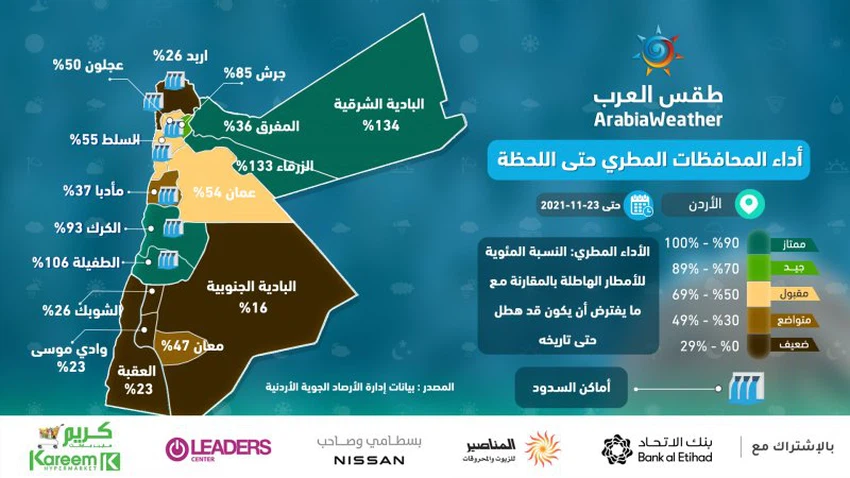A new study of Arab weather shows the great variation in the performance of the rainy season in the Jordanian governorates
Arab Weather - The data of the Jordanian Meteorological Department showed that the percentage of what has been achieved from the season until now was only 6.4% , while the same data indicated that the performance of the rainy season did not exceed 59% compared to the amounts of rain that are supposed to be falling for this time of the year. Where it is assumed that this percentage in normal conditions is more than 90%.
These data and values indicate an acceptable rain performance since the beginning of this fall, but it is not good in light of the concern about the water situation in Jordan and the region.
Download the Arab Weather app to view all weather news and bulletins
The following is a new report issued by the Arab Weather Center diagnosing the rainy situation in Jordan:
First: The amount of rainfall achieved relative to what is assumed until (22-11-2021)
The statistical report on rain shows that most regions of the Kingdom are recording an acceptable rain performance until now, when comparing what has been achieved from the actual amount of rain that falls in this rainy season with what is supposed to fall (which is calculated based on what was recorded on the ground during the past thirty years) , we find that no region has exceeded the assumed rainfall total, and that some regions of the Kingdom suffer from great scarcity of rain and poor rain performance, namely: Irbid, the Southern Badia, Shobak, Wadi Musa and Aqaba.
The same statistical report shows that the rain performance increased in the capital and the entire central eastern and western regions, recording about 93%, and the rain performance in the southern Jordan Valley (Ghor al-Safi) did not exceed 15%.

In a positive matter, specialists in Arab weather confirm that the final total of the rainy season does not depend on the rain falling only during the autumn season, and that there are many seasons in which the fall did not witness any good rain, while the final rain totals for the season ended with rain amounts around or above the seasonal rates. .
Second: A large variation in rain performance among the governorates of the Kingdom
The statistical report issued by the Jordan Meteorological Department shows that there is a great discrepancy in rain performance among the governorates of the Kingdom, while Jerash governorate recorded a good rain performance among the northern governorates, reaching 85%, but Irbid governorate witnessed weak precipitation and the percentage of rain performance did not exceed 26%.
The same is true for the central governorates, where the capital, Amman and Salt, recorded an acceptable performance of about 54%, but the rain performance was poor in the governorate of Madaba, at a rate of 37%, and the contrast was greater with the governorates of Karak and Tafila, which recorded excellent rain performance of 93% and 106 % (Respectively).
Third: The reason for the great disparity in rain performance among the governorates of the Kingdom
Specialists in Arab weather believe that the reason for the great rain variation between the governorates of the Kingdom is as a result of the Kingdom not being affected by an integrated system from an air depression with which rain falls initially in the north, then moves to the center, and then moves to the southern regions of the Kingdom on a regular basis.
Rather, the air system that affected the Kingdom was a state of atmospheric instability characterized by random and geographical irregularities in thunderstorms, and the same matter did not prevent heavy rains in some parts of the Kingdom.
Fourth: Forecasts for the rest of November
And the monthly bulletin for the month of November 2021, issued earlier by the Arab Weather Center, stated that the weather in November will be characterized by the following:
- The Red Sea depression dominates the Kingdom during many days of this month.
- Frequent blowing of easterly winds that will increase dust levels in the atmosphere and the subsequent effects on respiratory patients, eyes and allergies.
- Gradual improvement in the chances of rain, God willing, in the second half of the month.
- Monitoring an early extension of the Siberian air altitude at the end of the month, and forecasts of colder than usual weather and a recommendation to be aware of the possibility of frost formation at night in the Badia regions.
We ask God Almighty to grant us rain and goodness for the country
Arabia Weather App
Download the app to receive weather notifications and more..



